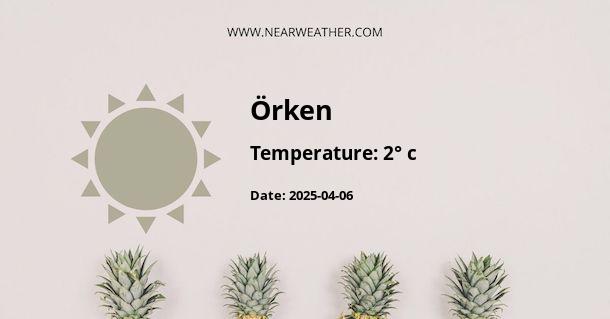The Climate and Weather of Örken, DE: A Comprehensive Overview
Örken, located in Delaware (DE), showcases a climate that encompasses characteristics of both a humid subtropical and humid continental climate due to its geographical position within the Mid-Atlantic region of the United States. The weather in Örken fluctuates seasonally, with hot, humid summers and generally mild to cool winters. This dynamic climate is influenced by both the Atlantic Ocean and the area's latitude, resulting in a diverse weather pattern throughout the year.
Seasonal Climate Variations
Understanding the seasonal weather patterns is essential for residents and visitors to plan activities, agricultural pursuits, and prepare for potential extreme weather events.
Spring
Spring in Örken is a season of transition, characterized by gradually increasing temperatures and a higher frequency of rain showers which contribute to the blossoming of local flora.
- Temperature: Average high temperatures range from the mid-50s to the upper-70s Fahrenheit (12-25 degrees Celsius).
- Precipitation: Rainfall averages around 3-4 inches (76-102 mm) per month.
Summer
Summer sees the arrival of hot and often humid conditions, with the influence of the nearby Atlantic Ocean leading to occasional tropical storms or hurricanes that impact the area, emphasizing the need for cautious weather monitoring.
- Temperature: Average high temperatures hover in the mid-80s to low-90s Fahrenheit (29-34 degrees Celsius).
- Precipitation: Monthly rainfall can be variable but averages around 4 inches (102 mm).
Fall
Autumn in Örken witnesses a gradual decrease in temperature and humidity, boasting picturesque foliage and a comfortable climate for outdoor recreation.
- Temperature: Average high temperatures range from the low-70s to the mid-50s Fahrenheit (21-13 degrees Celsius).
- Precipitation: Rainfall averages around 3-4 inches (76-102 mm) per month, with the added possibility of nor'easter storms.
Winter
Winter brings cooler temperatures which can fluctuate substantially. While snowfall in Örken is less significant than more inland locations, occasional snowstorms can occur, affecting transport and daily life.
- Temperature: Average high temperatures range from the mid-40s to the low-30s Fahrenheit (7-0 degrees Celsius).
- Precipitation: Monthly snowfall averages around 6-8 inches (152-203 mm), concentrated in the later months of the season.
Annual Weather Averages
A detailed understanding of the annual weather averages offers valuable insights, particularly for industry sectors such as tourism, construction, and agriculture, which are sensitive to climatic factors.
| Month | Avg. High Temp (°F) | Avg. Low Temp (°F) | Avg. Precipitation (in) |
|---|---|---|---|
| January | 43 | 28 | 3.3 |
| February | 47 | 30 | 2.8 |
| March | 55 | 37 | 4.3 |
| April | 65 | 46 | 3.8 |
| May | 75 | 56 | 3.7 |
| June | 84 | 65 | 3.5 |
| July | 88 | 70 | 4.5 |
| August | 86 | 68 | 4.4 |
| September | 79 | 61 | 4.0 |
| October | 68 | 50 | 3.6 |
| November | 58 | 41 | 3.3 |
| December | 48 | 32 | 3.5 |
Extreme Weather and Climate Events
Örken's proximity to the coast means that it can be susceptible to extreme weather events such as hurricanes, nor'easters, and tropical storms. These events emphasize the importance of effective emergency management strategies and continual monitoring of meteorological forecasts.
“The vulnerability of Örken to coastal storms necessitates stringent building codes and effective disaster preparedness programs.” – Local Emergency Services Coordinator
- Coastal flooding is a significant concern during hurricane and nor'easter events.
- Summer storms can bring damaging winds, heavy rains, and occasional hail.
- Winter storms are less frequent but can lead to significant snowfall and ice, disrupting transportation and utility services.
Impact of Climate on Local Lifestyle and Economy
The climate in Örken directly influences the local lifestyle, with residents and businesses often adapting their activities to accommodate seasonal weather patterns. The area’s climate is conducive to a range of economic activities including agriculture, fishing, and tourism.
- Agriculture: The farming season is framed by the first and last frost dates, which determine the growing season for various crops.
- Fishing: Weather patterns, particularly the temperature of coastal waters, affect migration patterns and the behavior of fish stocks, influencing the local fishing industry.
- Tourism: Climate and weather conditions determine peak tourism seasons, with summer being the busiest due to the favorable beach weather.
Climate Resilience and Sustainability in Örken
In light of climate variability and the potential for extreme weather events, Örken has taken steps to improve climate resilience and encourage sustainability within the community. Initiatives include investing in renewable energy sources, promoting water conservation, and implementing strategies for managing increased precipitation and potential flooding.
Conclusion
Overall, the climate and weather of Örken, DE, are markedly seasonal with the interplay between continental and maritime influences defining its unique weather patterns. By understanding these dynamics, residents and stakeholders can make informed decisions that take into account the impacts of weather on daily life, economic activities, and future planning. Continuous research and monitoring assist in comprehending these complex meteorological phenomena, thereby fostering a society that is both prepared for and adaptive to all seasons.
A - Örken's Latitude is 52.083328 & Longitude is 8.550000.
A - Weather in Örken is 4° today.
A - Climate Conditions in Örken shows clear sky today.
A - Humidity in Örken is 95% today.
A - Wind speed in Örken is 6.73 km/h, flowing at 87° wind direction. today.
